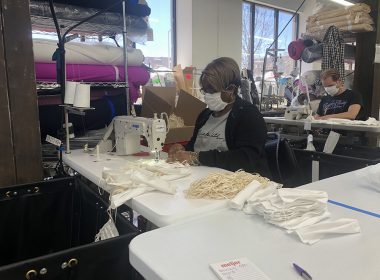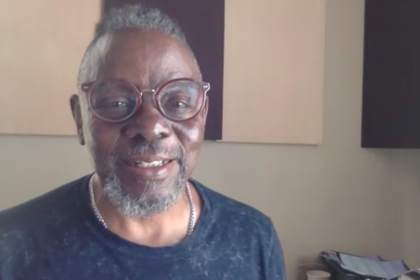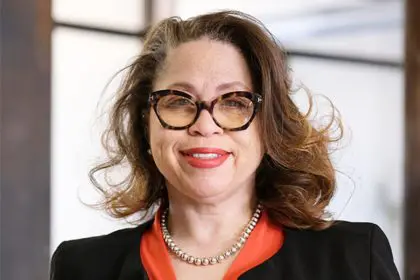
“Namaste” is a term commonly heard and used among yoga practitioners. Interpreted as “I bow to you,” it is meant to acknowledge the divine spark in everyone. Yoga Gardens is a small sanctuary nestled in North Lawndale, on the West Side of Chicago, with a growing following. It is where Indigo Monae is exposing yogi practitioners, young and old alike, to the centuries-old practice and meditation and helping her young students find the divine spark within themselves.
What was it like bringing yoga to Lawndale?
It was fantastic to bring yoga to Lawndale. Some of our students had heard about yoga before we introduced it, some of them had practiced yoga as a program through school, and some had no idea what yoga was, but, generally, folks were very curious and excited to try. It took off really quickly. Our students reported immediate benefits and would show up regularly for classes.
Aside from yoga, what other things go on at Yoga Gardens?
We teach a seated meditation, which has been surprisingly a hit. Our students love and really crave a seated, still and quiet meditation. We grow over 25 different varieties of fruits and vegetables and give them away to the community. All our produce is organic and non-GMO. We teach folks how to grow food, how to cook with that same food; we bring in guest musicians and dancers; we hold full-day functions with art projects, music, and dance. We take field trips.
A few years ago, it came to our attention that most of our students had never been to the beach, so we arrange a few trips every summer to the beach. We practice yoga and swim at the lake. We try and connect people with things they need. Sometimes that’s counseling, sometimes that’s resume help or job placement. We do many things on many different levels of service.
How has the overall reception been?
When we first broke ground, we were met with some real enthusiasm by some folks. A lot of the young men who were out in the streets actually helped us build the garden, which was a huge help. The first year we opened was the most work physically, and we received a lot of support from the kids that were hanging out in the area. Once we opened, kids sort of poured in and were very excited and curious. Some parents naturally were cautious, some assumed we were with a church. It took some time to build trust, but overall we were very well received.
How were you introduced to yoga?
I was first introduced to yoga in school. I was an athlete, and yoga aided with my performance in track and field and basketball. But it wasn’t until I met my best friend, who is also one of the founders of Yoga Gardens, Morr Solomon, that I dove into the practice of yoga. She introduced me to Ashtanga, which is a very traditional practice. We’ve practiced together for years prior to opening the garden.
We know there are some mental and physical benefits to yoga, but what do you see as the benefits particularly for people of color?
In urban communities, people of color often face higher rates of poverty, health-related issues, stress, incarceration and other social inequalities than other communities. Given the disproportionate hardships communities of color face in the United States, yoga can be a very powerful coping tool. We know yoga can reduce stress, increase health and provide an outlet for youth. Yoga as a spiritual practice has even turned lives around within the prison system. On a physical level, yoga improves the flexibility in the body, muscle toning and blood circulation, which detoxifies the body of harmful things. This practice aids in controlling blood pressure and balancing the hormonal systems of the body. Yoga reduces pain in the spine, joints [and] back and [as well as] migraines. Mentally, yoga improves concentration, focus, and clarity. It reduces stress, combats depression, aids with anxiety, stabilizes moods and enhances feelings of personal well-being.
Do you plan to expand your work to other areas in the city?
For now, we have the vision to expand our program within the community we already serve. We would like to include a facility where we can run yoga and meditation programs throughout the year for residents in this neighborhood [because it has] a few wellness spaces or healthy food options. Also, our students need and have requested that we continue our programming throughout the winter. Currently, we do not have a space to host winter activities. We are working on expanding our physical location to include more space for growing food and several structures which can accommodate classes and programs. Once we accomplish this, we plan to use this model to create Yoga Gardens in other resource-poor communities across Chicago.
You had the opportunity to study in India. What was that experience like, and what did you learn from it?
The opportunity to study in India with one of the greatest yogis, Sharath Jois, of our time was life-changing. Traveling alone in a foreign country as a woman of color from America was challenging, but it was also eye-opening. I was in India for over five months. I did a 10-day silent meditation [and] traveled around meeting wonderful people and creating memories that will be with me forever. This was a once-in-a-lifetime opportunity, and India taught me the beauty of opening my heart. It woke me to understand my own privilege of being an American and showed me a way to create true change in my city. While on this journey, I learned that freedom is a state of mind, and if you can get control of your everyday thought, you can change your outcome.
















